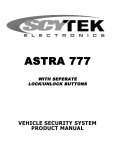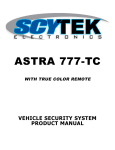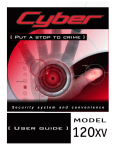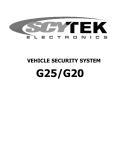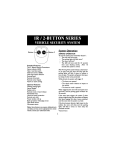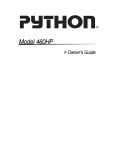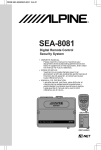Download Clarion S100 User's Manual
Transcript
Model S100
➤Owner’s Guide
limited lifetime consumer warranty
This Ungo Pro Security system is warranted against defects in material and workmanship.
The main unit is covered by this limited lifetime warranty. This Limited Lifetime
Warranty applies to Ungo Pro Security systems that have been installed by an authorized
Ungo Pro Security dealer. This warranty is to the Original Purchaser ("Owner") and to
the original vehicle in which it was installed into. This warranty is not transferable to any
subsequent owner(s) of the product(s).
Warranty Program:
Main Unit
Remote Controls
Siren
Shock Sensor
LED
Override Switch
Limited Lifetime
One year from date of purchase
One year from date of purchase
One year from date of purchase
One year from date of purchase
One year from date of purchase
The Warranty does not cover batteries or products deemed damaged through alterations
or installation. It also does not cover products mishandled, misused, neglected, abused,
water damaged, or with removed/altered serial numbers.
PROOF OF PURCHASE WILL BE REQUIRED FOR WARRANTY SERVICE OF
THIS PRODUCT.
This warranty does not cover the costs incurred for removal or reinstallation of the main
unit and/or any damage to the vehicle or the vehicle's electrical system.
The sole responsibility of Clarion Corporation of America ("Clarion") under this
Warranty shall be limited to the repair or replacement of the product, at the sole
discretion of Clarion.
If it becomes necessary to send the product or any defective part to Clarion, the product
must be shipped in its original carton or equivalent carton, fully insured, with shipping
charges prepaid. Clarion will not assume any responsibility for any loss or damage
incurred in shipping.
ALL IMPLIED WARRANTIES EXCEPT TO THE EXTENT PROHIBITED BY
APPLICABLE LAW SHALL HAVE NO GREATER DURATION THAN THE
WARRANTY PERIOD SET FORTH ABOVE. UNDER NO CIRCUMSTANCES
SHALL CLARION CORPORATION BE LIABLE FOR ANY LOSS OR DAMAGE,
DIRECT OR CONSEQUENTIAL, ARISING OUT OF THE USE OR INABILITY
i
TO USE OF THE PRODUCT. BECAUSE SOME STATES DO NOT ALLOW
LIMITATIONS ON HOW LONG AN IMPLIED WARRANTY LASTS OR EXCLUSIONS OR LIMITATIONS OF INCIDENTAL OR CONSEQUENTIAL
DAMAGES, THE ABOVE LIMITATIONS OR EXCLUSIONS MAY NOT APPLY
TO YOU.
THIS WARRANTY GIVES YOU SPECIFIC LEGAL RIGHTS, AND YOU MAY
ALSO HAVE THE OTHER RIGHTS, WHICH VARY FROM STATE TO STATE.
Should you have any difficulties with the performance of this product during warranty,
please call: 1-800-GO-CLARION or visit your local Ungo Pro Security dealer. You may
also contact the National Service Manager at the following address below for additional
service help you may need.
Clarion Corporation of America
Attn: National Service Manager
661 W. Redondo Beach Blvd.
Gardena, Ca 90247
ii
table of contents
limited lifetime consumer warranty . . . . . . . . . . . . . . . . . . . . . . . . . . . . . . .i
standard remote configuration . . . . . . . . . . . . . . . . . . . . . . . . . . . . . . . . . . .2
what is included . . . . . . . . . . . . . . . . . . . . . . . . . . . . . . . . . . . . . . . . . . . . . . .3
important information . . . . . . . . . . . . . . . . . . . . . . . . . . . . . . . . . . . . . . . . . .3
system maintenance . . . . . . . . . . . . . . . . . . . . . . . . . . . . . . . . . . . . . . . . .4
fcc/id notice . . . . . . . . . . . . . . . . . . . . . . . . . . . . . . . . . . . . . . . . . . . . . . . .4
remote functions . . . . . . . . . . . . . . . . . . . . . . . . . . . . . . . . . . . . . . . . . . . . . .4
using your system . . . . . . . . . . . . . . . . . . . . . . . . . . . . . . . . . . . . . . . . . . . . . .6
active arming . . . . . . . . . . . . . . . . . . . . . . . . . . . . . . . . . . . . . . . . . . . . . . .6
passive arming . . . . . . . . . . . . . . . . . . . . . . . . . . . . . . . . . . . . . . . . . . . . . .6
remote sensor bypass . . . . . . . . . . . . . . . . . . . . . . . . . . . . . . . . . . . . . . . .8
arming while driving . . . . . . . . . . . . . . . . . . . . . . . . . . . . . . . . . . . . . . . . .9
disarming . . . . . . . . . . . . . . . . . . . . . . . . . . . . . . . . . . . . . . . . . . . . . . . . . .9
silence alarm without disarm . . . . . . . . . . . . . . . . . . . . . . . . . . . . . . . . . . .9
disarming without a remote . . . . . . . . . . . . . . . . . . . . . . . . . . . . . . . . . . .10
silent mode . . . . . . . . . . . . . . . . . . . . . . . . . . . . . . . . . . . . . . . . . . . . . . .11
panic mode . . . . . . . . . . . . . . . . . . . . . . . . . . . . . . . . . . . . . . . . . . . . . . .11
override mode . . . . . . . . . . . . . . . . . . . . . . . . . . . . . . . . . . . . . . . . . . . . .12
false alarm prevention circuitry . . . . . . . . . . . . . . . . . . . . . . . . . . . . . . . .13
diagnostics . . . . . . . . . . . . . . . . . . . . . . . . . . . . . . . . . . . . . . . . . . . . . . . . . .14
arming diagnostics . . . . . . . . . . . . . . . . . . . . . . . . . . . . . . . . . . . . . . . . . .14
disarming diagnostics . . . . . . . . . . . . . . . . . . . . . . . . . . . . . . . . . . . . . . .14
system status chirps . . . . . . . . . . . . . . . . . . . . . . . . . . . . . . . . . . . . . . . . .15
table of zones . . . . . . . . . . . . . . . . . . . . . . . . . . . . . . . . . . . . . . . . . . . . .16
interpreting zone diagnostics . . . . . . . . . . . . . . . . . . . . . . . . . . . . . . . . . .16
anti-code grabbing . . . . . . . . . . . . . . . . . . . . . . . . . . . . . . . . . . . . . . . . . . . .17
high frequency . . . . . . . . . . . . . . . . . . . . . . . . . . . . . . . . . . . . . . . . . . . . . . .17
individual remote recognition . . . . . . . . . . . . . . . . . . . . . . . . . . . . . . . . . . .18
power-up . . . . . . . . . . . . . . . . . . . . . . . . . . . . . . . . . . . . . . . . . . . . . . . . . . . .18
power saving mode . . . . . . . . . . . . . . . . . . . . . . . . . . . . . . . . . . . . . . . . . . .19
programming options . . . . . . . . . . . . . . . . . . . . . . . . . . . . . . . . . . . . . . . . .20
installation options . . . . . . . . . . . . . . . . . . . . . . . . . . . . . . . . . . . . . . . . . . .23
anti-carjacking system . . . . . . . . . . . . . . . . . . . . . . . . . . . . . . . . . . . . . . . . .24
arming the anti-carjacking system . . . . . . . . . . . . . . . . . . . . . . . . . . . . . .24
anti-carjacking triggered sequence . . . . . . . . . . . . . . . . . . . . . . . . . . . . . .25
disarming the anti-carjacking system . . . . . . . . . . . . . . . . . . . . . . . . . . . .26
glossary of terms . . . . . . . . . . . . . . . . . . . . . . . . . . . . . . . . . . . . . . . . . . . . .27
security & convenience expansions . . . . . . . . . . . . . . . . . . . . . . . . . . . . . . .29
1
standard remote configuration
controls the Arm function.
controls the Disarm function.
controls Silent Arm/Disarm and an Auxiliary output.
controls the Panic function.
and
2
pressed together control an Auxiliary output.
what is included
➤
One control module
➤
A pair of four-button remotes
➤
A dual-stage shock sensor
➤
A six-tone programmable siren
➤
The blue status LED indicator light
➤
A push-button override switch
➤
Starter kill ready circuitry (may require additional labor)
➤
External receiver/antenna
important information
Congratulations on the purchase of your state-of-the-art vehicle security system. This system has been designed to provide years of troublefree operation. Due to the complexity of this system, it must be installed
by an authorized dealer only. Installation of this product by anyone other
than an authorized dealer voids the warranty.
This owner’s guide should help you to get the most out of your system.
Please take the time to read it prior to using the system.
3
system maintenance
The system requires no specific maintenance. Your remote control is
powered by a small, lightweight 3 volt lithium battery that will last
approximately one year under normal use. When the battery weakens,
operating range will be reduced and the LED on the remote will dim.
fcc/id notice
This device complies with Part 15 of FCC rules. Operation is subject to
the following two conditions: (1) This device may not cause harmful
interference, and (2) This device must accept any interference received,
including interference that may cause undesirable operation.
Changes or modifications not expressly approved by the party responsible for compliance could void the user's authority to operate this device.
remote functions
This system uses a computer-based learn routine to learn the remote
buttons. This makes it possible to assign any remote button to any system function. The remote initially comes programmed with Standard
Configuration, but may also be customized by an authorized dealer. The
buttons in all of the instructions in this manual correspond to a
Standard Configuration remote.
4
standard configuration
Button
The arming function is controlled by pressing this button for one second.
Button
The disarming function is controlled by pressing this button for one second.
Button
Silent Arm/Disarm and an optional auxiliary function are controlled by
pressing this button. (Silent Arm/Disarm works by pressing this button
for less than one second before arming or disarming. An optional auxiliary function, such as trunk release, can be controlled by pressing this
button for 1.5 seconds.)
The auxiliary output controls __________________________.
Button
The panic feature is controlled by pressing this button for two seconds.
and
Buttons
An optional auxiliary convenience or expansion function that you have added
to your system can be activated by pressing these buttons simultaneously.
The auxiliary output controls __________________________.
5
using your system
The buttons used in the instructions in this manual correspond to the
standard configuration. Remember, this is not the only way your
remote may be set up. It can be custom configured to meet your needs.
active arming
You can activate, or arm, the system by pressing
on your remote for
one second. When the system arms, you will hear a short siren sound, or
chirp, and the parking lights will flash once. If the vehicle’s power door
locks have been connected to the system, the doors will lock.
While the system is armed, the status LED will flash approximately once
per second, indicating that the system is actively protecting your vehicle. If you hear a second chirp after arming, and see the status LED
flashing in groups, refer to the Diagnostics section of this guide. This
extra chirp is notification of an open zone.
passive arming
The system also can be programmed to arm itself automatically (called
passive arming). If the system is programmed for passive arming, it will
automatically arm 30 seconds after the ignition is turned off and the
system "sees" you leave the vehicle by opening and closing a door.
Whenever the system is in its 30-second passive-arming countdown,
the status LED will flash twice as fast as it does when the system is
armed. The siren will chirp once 20 seconds after the last door has been
closed. The system is not actually armed at that point. The system arms
and the doors lock (if connected and programmed for passive locking)
at the 30 second mark, but the siren will not chirp. The early chirp pro6
vides you with a 10-second warning prior to arming.
note: If any protected entry point (such as a door or a switchprotected trunk or hood) is open, the system will not passively arm (unless forced passive arming is programmed on). See
Programming Options section of this guide. Additionally,
each time a protected entry is triggered during the arming
countdown, the 30-second countdown starts over.
When armed, your vehicle is protected as follows:
➤
Light impacts will trigger a warning signal. When triggered, the
siren will chirp and the parking lights will flash for a few seconds.
➤
Heavy impacts will trigger the system. The triggered sequence
is between 1-180 seconds of constant siren and flashing
parking lights.
➤
If a door is opened, the system will immediately start chirping
the siren and flashing the parking lights. Three seconds later,
the siren output changes to a continuous blast. This progressive response gives you time to disarm the system with your
remote if you inadvertently open the door while the system is
armed, while still providing an instant response (even if the
door is immediately closed).
➤
Turning on the ignition key will trip the same two-stage
response as opening a door.
➤
The optional starter kill prevents the vehicle’s starter from cranking.
7
remote sensor bypass
Remote Sensor Bypass allows you to select which of the security system's inputs or sensors will be active and which will be bypassed at the
time that the system is armed. (See the Table of Zones section of this
guide.) Pressing
again within five seconds of arming the security
system will activate the Remote Sensor Bypass feature. Each time
is pressed again, a different security level is selected. The different security levels can be selected as follows:
➤
Press
one time: The siren chirps once. The system is
armed.
➤
Press
a second time within five seconds: The siren chirps
twice followed by a long chirp. Zone 2 is now bypassed.
➤
Press
a third time within five seconds: The siren chirps
three times followed by a long chirp. Zone 4 is now bypassed.
➤
Press
a fourth time within five seconds: The siren chirps four
times followed by a long chirp. Zones 2 and 4 are now bypassed.
➤
Press
a fifth time within five seconds: The siren chirps
five times followed by a long chirp. All input zones, except
the ignition, are now bypassed.
➤
Continued pressing of
will begin the Remote Sensor
Bypass cycle over again.
note: Remote Sensor Bypass only applies to a single arming
cycle. Once the system is disarmed and then re-armed, all
the zones will be active again.
8
arming while driving
Your system can be armed while driving the vehicle. Simply press
on
your remote for two seconds while the vehicle is running or while the ignition is on. The siren will chirp once and then once more to indicate that
the ignition is on. The security system will not respond to any input except
the door triggers and the Starter Kill (if installed) will not be activated. The
security system will disarm automatically whenever the ignition is turned
off. The siren will chirp twice and the LED will stop flashing.
note: If programmed for the optional Anti-Car Jacking feature, arming with the remote will arm this feature. (See AntiCar Jacking section of this guide.)
disarming
To disarm the system, press
. You will hear two chirps, and the
parking lights will flash twice. If the power locks are connected to the
system, the doors will unlock. If the siren chirps either four or five times
when disarming, refer to the Diagnostics section of this guide to determine which zone caused the system to alarm.
silence alarm without disarm
This feature makes it possible to silence and reset the system while it is
triggering, without disarming the system. If the system is triggered and
the siren has been sounding for longer than six seconds, pressing
or
on the remote will stop the trigger and return the unit to
the armed state. The system will not disarm, but rather reset. This prevents you from disabling the system should you wish to disarm it without visually checking the vehicle. Pressing
after resetting the system will disarm the system; pressing this button during the first six seconds of the triggered sequence will disarm the security system imme9
diately. The six second timer is provided for your convenience, in case
the system is accidentally triggered.
disarming without a remote
This feature allows you to disarm the security system without the
remote should it be lost, damaged, or disabled. In order to disarm the
system without a remote, you must have the vehicle’s ignition key and
know where the override switch is located. Be sure to check with the
installer for the location and the number of presses of the override
switch required to disarm the system.
To disarm the security system,
turn the ignition to the ON position. Press the override switch the
preset number of times (one to
DRW-35
five times) within 15 seconds.
After five seconds the system will
disarm. If the system does not
disarm, you may have waited too
long; turn the ignition off and on
and try again.
Location of override switch _________________________________
Number of Pulses ________________________________________
important! The unit can be programmed to respond to one to
five pulses of the override switch for the disarm function. Be
sure to check with the installer for the desired programming.
10
silent mode
To temporarily turn off the arm or disarm chirps, use Silent Arm/Disarm.
Simply press
for less than one second before arming or disarming,
and the confirmation chirp(s) will be eliminated for that one operation
only. If you want the arm/disarm chirps turned off permanently, your
dealer can do this for you.
note: The warning response to lighter impacts is bypassed if
the system is armed using Silent Arm/Disarm. This ensures
that no chirps will be emitted by the siren in an area you
want chirp-free. The system is still fully capable of triggering.
Only the warning response is bypassed.
panic mode
If you are threatened in or near your vehicle, you can attract attention
by triggering the system with your remote. Just press
for two sec-
onds, and you will enter Panic Mode. The siren will sound and the parking lights will flash for the programmed siren duration. To stop Panic
Mode at any time, press
on the remote remote again.
11
override mode
You can prevent your security system from automatically arming and
triggering by using Override Mode. This is very useful when washing the
vehicle or having it serviced. In Override Mode, the security system will
not arm, even with the remote remote, but all convenience functions
(door locks, trunk release, etc.) will continue to work normally.
To enter or exit Override Mode:
1.
Turn the ignition on.
2.
Turn the ignition off.
DRW-35
3.
Press and release the Override switch
within 10 seconds.
The status LED will light solidly if you are entering Override Mode, and
it will go out if you are exiting Override Mode.
To enter or exit Override Mode using the remote:
1.
Open any vehicle door.
2.
Press
3.
Press
4.
Press
.
again.
The status LED will light solidly if you are entering Override Mode, and
it will go out if you are exiting Override Mode.
12
false alarm prevention circuitry
Your system has false alarm prevention circuity. It prevents annoying
repetitive trigger sequences due to faulty door pin switches or environmental conditions such as thunder, jackhammers, airport noise, etc.
Example
If the alarm triggers three times within a 60-minute period and each
time the same sensor or switch triggers the alarm, The system will interpret those triggers as false alarms. After the third trigger, The system
ignores, or bypasses, that sensor or switch (along with any other sensors or switches sharing the same zone) for 60 minutes.
If the bypassed sensor tries to trigger the system while it is being
bypassed, the 60-minute bypass period will start over. This ensures that
a sensor that continually triggers will remain bypassed.
Doors are covered by system differently; if the alarm is triggered by an open
door for three full cycles, the doors will be bypassed until the trigger ceases.
note: Arming and disarming the system does not reset this function.The only ways to reset a bypassed zone are for it to not
trigger for 60 minutes, or to turn on the ignition. If testing your
system, it is important to remember that the false alarm prevention circuitry programming can cause zones to be
bypassed and appear to stop working. If five chirps are heard
when disarming, false alarm prevention circuitry has been
engaged. If you wish to clear the false alarm prevention circuitry memory, turn the ignition key on.
See Programming Options section of this guide for false alarm
circuitry programming.
13
diagnostics
The microprocessor at the heart of your security system is constantly
monitoring all of the switches and sensors that are connected to it. It
detects any faulty switches and sensors and prevents them from disabling the entire system. The microprocessor will also record and report
any triggers that occurred during your absence. Refer to the System
Status Chirps and Table of Zones charts for diagnostic information.
arming diagnostics
If the system is armed while an input is active (door open, sensor triggering, etc.) the unit will chirp once when arming and then one more time a
few seconds later. This is notification that the zone is opened or bypassed.
note: The open zone notification will not occur when using
Silent Arm/Disarm or if chirps have been programmed OFF.
The security system will ignore the input that was active when the system was armed, until the input goes away. Three seconds later the system will monitor that input normally. For example, if your vehicle has
interior light exit delay, and you arm the system before the interior light
goes out, you may hear open zone notification chirps. Once the light
shuts off, however, the doors are monitored normally.
disarming diagnostics
Extra disarm chirps are notification that the alarm was previously triggered. If four chirps are heard when disarming, the system was triggered in your absence. If five chirps are heard, a zone was triggered so
many times that false alarm prevention circuitry has bypassed that
zone. The status LED will indicate which zone was involved. (See Table
14
of Zones section of this guide.) The system will retain this information
in its memory, and continue to chirp four or five times each time it is
disarmed, until the next time the ignition key is turned on.
system status chirps
The siren will chirp when arming/disarming the system. The pattern of
chirps will audibly report the system’s status as described below.
Action
Number of Chirps
Description
Arm
1
System armed
Arm
1 (3-second delay), 1
System armed with
open zone notification
Disarm
2
System disarmed
Disarm
4
System disarmed with
previous alarm notice
Disarm
5
System disarmed false
alarm circuitry active
15
table of zones
The zone number is the number of LED flashes used by the system to
identify that input. The standard input assignments are listed below,
along with spaces to write in any optional sensors or switches you have
had installed.
Zone - Number
of LED Flashes
Description
Dealer-Installed
Options
1
Instant trigger - often used
for hood/trunk pinswitches
2
Instant trigger - a heavier impact
detected by the shock sensor
3
Door switch trigger
4
Instant trigger - for optional sensors
5
Ignition trigger
interpreting zone diagnostics
Warn Away responses are not reported by arming or disarming diagnostics. If you receive a open zone notification when arming, or a notification of an alarm in your absence when disarming, look at the LED. Active
or triggered zones will be indicated by a pattern of blinks by the LED.
Example
If Zone 3 was active or triggered, the LED will blink three times with a
two-second pause. Then it will blink three times again, and repeat until
the ignition is turned on.
16
note: Your system stores the last two triggered zones in memory. If your system has been triggered but the LED has been reset
by turning on the ignition, your dealer can still recall the last
two zones that were triggered. Contact your dealer for details.
anti-code grabbing
The receiver and remotes each use mathematical formulas called algorithms to change their codes each time the remote is used. This technology has been developed to increase the security of the unit. The control
unit knows what the next codes should be. This helps to keep the remote
"in sync" with the control unit even if you use the remote control out of
range of the vehicle. However, if the remote has been pressed many
times out of range of the vehicle, or if the battery has been removed, it
may get out of sync with the control unit and fail to operate the system.
To re-sync the remote control simply press
of the remote several
times within range of the vehicle. The alarm will automatically re-sync
and respond to the remotes normally.
high frequency
Your system transmits and receives at 434 MHz. This provides a cleaner
spectrum with less interference and a more stable signal. Enjoy a phenomenal increase in range – even in areas with high radio interference.
17
individual remote recognition
Individual remote recognition is a feature available. Using the Pro
Security Programmer, a hand-held programming tool, your dealer can
program many of the system settings. The programmer makes it possible to program different settings for each remote that is used with the
system. Then, whenever a specific remote is used, the system will recall
the settings assigned to that remote. Individual recognition lets up to
four users of the system have different settings that meet their specific needs. It is almost like having four separate alarms in your vehicle,
one for each user.
note: This individual recognition cannot be programmed
without a Pro Security Programmer and the necessary software. Check with your dealer for more information.
power-up
This system will store its current state to non-volatile memory. If power
is lost and then reconnected, the system will recall the stored state from
memory. This means if the unit is in valet mode and the battery is disconnected for any reason, such as servicing the car, when the battery is
reconnected the unit will still be in valet mode. This applies to all states
of the system including arm, disarm, anti-carjacking, and valet mode.
18
power saving mode
Your system will automatically enter a power saving mode while armed
or in valet mode, after a period of time in which no operation has been
performed. This lowers the current draw to the vehicle’s battery. Power
Saver mode takes over under the following conditions:
➤
Power saving when the system is armed: After the system has
been armed for 24 hours, the LED will flash at half its normal
rate, decreasing the system's current draw.
➤
Power saving in valet mode: When the system enters valet
mode the LED illuminates steadily. If the vehicle is not used
(ignition is not turned on) for a period of one hour while the
system is in valet mode, the LED will shut off. If the system
remains in valet mode, the LED will come back on the next
time the ignition is turned on and then back off.
19
programming options
Programming options control what your system does during normal
operation, and require few or no additional parts. However, some may
require additional installation labor.
The following is a list of the program settings, with the factory settings
in Bold:
➤
Active arming (only with the remote) or passive arming (automatic arming 30-seconds after the last door has been closed).
➤
Arming/disarming confirmation siren chirps on or off.
➤
The ignition controlled door lock feature on or off: With this
feature on, the doors will lock three seconds after the ignition
is turned on, and unlock when the ignition is turned off. The
system will not lock the doors when the ignition is turned on
with any door open. If your installer is programming the
security system with the Pro Security Programmer, ignition
lock and unlock are independent features and can be
programmed separately.
➤
Passive door locking (with passive arming) or active door
locking (only when arming with the remote). Passive locking
allows the vehicle's doors to lock when the security system
passively arms (after the 30 second countdown). This feature
only works if passive arming has been programmed.
note: When programmed for passive arming and active
lock, if the system is disarmed without a door being opened,
the system will relock the doors when it passively rearms.
20
➤
Panic mode enabled/disabled with the ignition on: Some
states have laws against siren capability in a moving vehicle.
➤
Forced passive arming on or off: If your system is
programmed for passive arming and the forced passive
arming feature has been programmed on, the system will
passively arm after one hour, even if a protected entry has
been left open. This feature is useful if a door has been left
ajar when leaving the vehicle. Forced passive arming ensures
that the security system will be armed in every situation.
note: When the system passively arms after one hour, the entry
point that has been left open, and anything connected to the
same zone, is bypassed and cannot trigger the system. However,
the remaining inputs to the system are fully operational.
➤
Automatic Engine Disable (AED) on or off: The purpose of
this feature is to protect the vehicle from being stolen at all
times, regardless of whether or not the alarm is armed. If AED
is programmed on, the starter of the vehicle will be disabled
30 seconds after the ignition is turned off. Once the key is
turned off, the LED will flash slowly (one-half its normal
armed rate) to indicate the AED arming cycle. Thirty seconds
later, the starter of the vehicle will be disabled. To start the
car, it will be necessary to disarm the system with the remote.
It is also possible to disarm the AED feature by turning the
ignition key to the RUN position and pressing the Override
switch the programmed number of times. AED is disabled
when the system is in valet mode.
21
note: This feature will only function if the Starter Kill relay has
been installed.
➤
Full trigger response 30 or 60 seconds: This determines how
long the full triggered sequence lasts. Some states have laws
regulating how long a security system can sound before it is
considered a nuisance. If your installer is programming the
security system with the Pro Security Programmer, the full
triggered response can be programmed for any duration
ranging from 1 to 180 seconds.
➤
False alarm prevention Circuitry on or off: Please refer to the
false alarm prevention circuitry section of this manual for a
further explanation. If the false alarm prevention circuitry is
programmed off, the security system will respond to inputs
from any sensor indefinitely.
note: Because many states have laws regulating security systems, programming false alarm prevention circuitry off may
cause your system to violate state laws.
➤
Progressive door trigger on or off: When the system is armed
and a door is opened, the system responds with ten chirps prior
to beginning the full triggered sequence. If an instant trigger is
desired, the progressive door trigger can be programmed off.
➤
Override pulse count: The number of presses of the Override
switch required to disarm the security system, AED, or the
Anti-Carjacking system can be programmed from one to five
presses. The default setting is one press.
➤
22
Siren tones and chirp volume: The output of the siren consists
of six different tones in sequence. Any of these tones can be
eliminated by your dealer, resulting in a unique, easily identifiable siren sound. The siren chirps can be either full volume
or six decibels quieter than the full alarm blast.
installation options
The system has many options that may require extra parts and labor.
Some of the possibilities are listed here.
➤
Progressive unlocking: In most cars with electric power door
locks, the system can be configured so that when the system
is disarmed, only the driver’s door unlocks. A second press of
the
➤
button unlocks the other doors.
Anti-Carjacking System is designed to help in the safe
recovery of your vehicle in case of a carjacking. Please refer to
the Anti-Carjacking System section of this guide for a
complete explanation of how this operates.
23
anti-carjacking system
The optional anti-carjacking system feature is designed to ensure that any
unauthorized user of your vehicle (even if using your keys and remote
control) will not be able to permanently separate you from your vehicle.
This system cannot prevent a carjacking attempt; however, it does ensure that if your vehicle is taken by an unauthorized user, it will be disabled (after several progressive warnings) as safely as possible. Should a
carjacking occur, the anti-carjacking system allows you to concern yourself with your personal safety without worrying about your property.
The Starter Kill, and the Anti-Carjacking features provide the best combination of personal safety and property protection available. When
properly installed, the system can never inadvertently stop your vehicle
in traffic or on railroad tracks while the vehicle is in operation. It is
unlike other systems that shut down your engine while it is running.
This system is designed to perform starter interrupt, or starter kill. The
Starter Kill cannot shut down an already-running engine – it can only
prevent an engine from starting in the first place.
important! Any installation that allows this product to shut
down a vehicle's engine when it is running is contrary to the
product’s design and intended usage, and Ungo hereby expressly disclaims any liability resulting therefrom.
arming the anti-carjacking system
To arm the anti-carjacking system, turn the ignition to the ON position
and press the arm button on the remote remote for one second. The
parking lights will flash and the siren will chirp once. This can be done
before driving or while driving the vehicle. Once the system is armed,
24
it will initiate its triggered sequence (see below) if any door is opened
and closed. If you are forced from the vehicle, the system will trigger as
the door is opened and closed. This is how the system works to combat intersection carjacking. To protect against parking lot carjacking,
arm the Anti-Carjacking System before leaving the vehicle. The system
will now trigger automatically the next time you or anyone drives the
vehicle. This helps to protect the vehicle if someone takes your keys and
remote by force in a parking lot.
note: If the Anti-Carjacking system is armed while operating
the vehicle and not disarmed prior to leaving the vehicle, it is
still armed and will trigger the next time the vehicle is driven.
anti-carjacking triggered sequence
Fifteen seconds after the last door has closed, the system’s status LED
will begin flashing. This delay is intended to allow you time to distance
yourself from your vehicle in the event of a carjacking.
Forty-five seconds later, the siren begins chirping and the parking
lights begin flashing. This time could be used to notify authorities that
your vehicle has been hijacked, and tell them what the Anti-Carjacking
system will do next.
Fifteen seconds after the siren chirps begin, the siren’s output will
change to a continuous blast.
From this point on, when the ignition key is turned off, the system will
immediately turn on the starter kill. This will prevent the vehicle from
being restarted, thus immobilizing it at that spot.
Three minutes after the constant siren output begins, the flashing
parking lights and the siren will stop. The starter kill will remain active
25
until the system is disarmed. If the door is opened or the ignition is
turned off and on in an attempt to restart the car, the siren and light
flashing will begin again.
disarming the anti-carjacking system
Take the time to familiarize yourself with the anti-carjacking triggering
sequence and the disarm procedure. It is important to recognize and
identify the trigger sequence and know how to disarm it in case of accidental activation.
Once the anti-carjacking system is armed, it does not disarm automatically. You must disarm it the next time you operate the vehicle. You
must disarm it with one of the following procedures:
If the system has not entered the triggered sequence (siren has not
started chirping):
1. Turn the ignition on.
2. Press
on the remote for one second. The lights
will flash and the siren will chirp twice.
If the system has entered the triggered sequence (siren has begun
chirping), pressing the disarm button of the remote will not disarm the
Anti-Carjacking System. To disarm the system during an AntiCarjacking System trigger sequence:
1. Turn the ignition on.
2. Press the Override switch the pre-proDRW-35
grammed number of times to disarm the
Anti-Carjacking System.
26
note: If the Anti-Carjacking system has begun its chirping
sequence, the ignition must be turned off, then on to disarm. If
you are driving the vehicle at the time, pull to a safe place away
from traffic and follow the triggered sequence disarm procedure.
glossary of terms
Control Unit: The "brain" of your system. Usually hidden under the
dash area of the vehicle. It houses the microprocessor which monitors
your vehicle and controls all of the system's functions.
Starter Kill: An automatic switch controlled by the security system
which prevents the vehicle’s starter from cranking whenever the system
is armed. The vehicle is never prevented from cranking when the system is disarmed, in valet mode, or should the starter interrupt switch
itself fail. Your system is ready for this feature, however installation may
require additional labor.
Input: A physical connection to the system. An input can be provided
by a sensor, pinswitch or through an existing system in the vehicle, such
as ignition or courtesy lights.
LED: Blue light mounted somewhere in the vehicle. It is used to indicate the status of your system. It is also used to report triggers and
faults in the system or sensors.
Shock Sensor: This is a sensor mounted in the vehicle that is designed
to pick up impacts to the vehicle or glass.
Siren: Noise generating device usually installed in the engine compart27
ment of the vehicle. It is responsible for generating the "chirps" you
hear, as well as the six tones you hear while the alarm is triggered.
Remote: Hand-held, remote control which operates the various functions of your system.
Trigger or Triggered Sequence: This is what happens when the alarm
"goes off" or "trips". The triggered response of your system consists of the
siren sounding and parking light flashing for the programmed duration.
Override Switch: A small push-button switch mounted somewhere
inside the vehicle. It is used to override the alarm when a remote is lost
or damaged, or to enter or exit valet mode.
Warn Away: Lighter impacts to the vehicle will generate the Warning
Zone response. It consists of several seconds of siren chirps and parking light flashes.
Zone: A zone is a separate input that the alarm can recognize as
unique. Each input to the system is connected to a particular zone. Two
or more inputs often share the same zone.
28
security & convenience expansions
Here we have listed only some of the many expansion options available. Please contact your dealer for a complete explanation of all the
options available to you.
Audio Sensor: Metal on glass, glass cracking, and breaking glass each
produce distinctive acoustic signatures. The audio sensor uses a microphone to pick up sounds, and then analyzes them with proprietary
acoustic software to determine if the glass has been struck.
Backup Battery: This keeps the system armed, triggers the alarm and
keeps the starter kill active if main battery power is disconnected.
Field Disturbance Sensor: An invisible dome of coverage is established by installing the "radar" sensor. Your security system can then
react to any intrusions into this field with the triggered sequence.
Headlight and Parking Light Automation: The option will automatically turn on your parking and headlights when it gets dark. In addition, it will turn your headlights on whenever the windshield wipers are
used. A remote function can also be used to turn on your parking and
headlights for a programmed time.
Power Trunk Release: The channel two output of the system can operate a factory power release for the vehicle’s trunk or hatch. (An additional relay may be required.) If the factory release is not power activated, then a trunk release solenoid can often be added.
Power Window Control: Power window control can be provided by
one of two systems. The firsts system provides control that will roll up
two windows automatically when the system is armed, or roll two win29
dows down by using the remote. The second system will roll two windows both up and down. This second system also provides one touch
switch operation.
Override Start System: For the ultimate in convenience, the Override
start system can start your vehicle, monitor engine functions, and
power your climate control system with a push of a button. Over-rev
protection, open-hood lockout, brake pedal shutoff, and automatic
timer shutoff are all included. (This feature is only for automatic transmission, fuel-injected gasoline vehicles.)
External Receiver/Antenna: An optional external receiver/antenna
can be used to upgrade the remote/receiver performance in areas of
high radio interference such as military bases, airports, and hospitals.
30
✂
QUICK REFERENCE GUIDE
To arm using your remote
Cut along dotted line and fold for a quick and easy reference to keep in your purse or wallet.
➤
You can activate, or arm, the system by pressing
on your remote for one
second. When the system arms, you will hear a short siren sound, or chirp, and
the parking lights will flash once. If the vehicle’s power door locks have been
connected to the system, the doors will lock.
To disarm using your remote
➤
To disarm the system, press
. You will hear two chirps, and the parking lights
will flash twice. If power locks are connected to the system, the doors will unlock.
If the siren chirps either four or five times when disarming, see Diagnostics
section. This is called notification of system alarming in your absence.
Arming while driving
➤
Press
on your remote for two second while the vehicle is running. The
system will chirp once and then once more to indicate that the ignition is on.
Disarming without a remote
➤
Turn on the ignition. Press the Override switch the programmed number of
times within 15 seconds. After five seconds, the system will disarm. If it does
not, you may have waited too long. Turn the ignition off and on and try again.
To enter or exit valet mode
➤
Turn ignition to RUN position, then turn to OFF position. Press and release
the Override switch within 10 seconds. The status LED will light solid if you
are entering valet mode, and it will go out if you are exiting valet mode.
To activate Panic Mode
➤
Press and hold
down for one second.
To exit Panic Mode
➤
Press
on the remote.
To activate Silent Arm/Disarm
➤
Press
briefly before arming or disarming, and the confirmation chirp(s)
will be eliminated for that one operation only.
Location of Override switch_______________________________
✂
Number of Override switch pulses for disarming_____________
31
32
Get Started
Get Protected
Ungo Pro Security
661 W. Redondo Beach Blvd.
Gardena, Ca. 90247
800-GO-CLARION
© 2003 Directed Electronics, Inc. - All rights reserved GS100 11-03





































